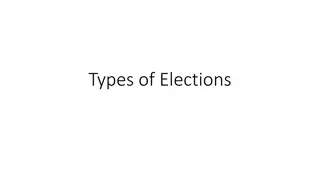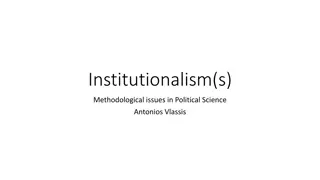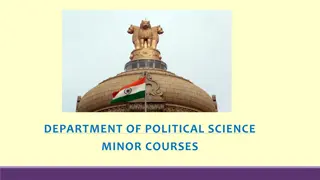Understanding Critical Elections Model: Political Realignments
Critical Elections Model explains significant shifts in party loyalty and control of the political system. Historical examples like the 1860 and 1932 elections showcase lasting impacts on government structures due to key issues that divided parties. The model highlights the importance of national issues, opposing party positions, and unified government in shaping major political realignments.
Download Presentation

Please find below an Image/Link to download the presentation.
The content on the website is provided AS IS for your information and personal use only. It may not be sold, licensed, or shared on other websites without obtaining consent from the author. Download presentation by click this link. If you encounter any issues during the download, it is possible that the publisher has removed the file from their server.
E N D
Presentation Transcript
THE CRITICAL ELECTIONS MODEL Explaining Political Realignments (a.k.a., When Elections Really Matter!)
Critical Elections Definition: A critical (or realigning ) election is one that results in a significant and lasting shift in party loyalty among voters and party control of the political system. Best Examples: 1) 1860 2) 1932
1860 Democrats had won 6 of the previous 8 presidential elections (1828-56). But in 1860, the party split over the issue of slavery in the territories. This gave rise to the modern Republican party.
1860 Republicans controlled the White House and both houses of the Congress for the next 14 years. Major legislative accomplishments: - Reconstruction Acts - 13th, 14th & 15th Amendments.
1860 Democrats would win just 3 of the next 18 presidential elections. And control both houses of Congress at the same time for just 8 of the next 72 years.
1932 Then came the Great Depression. By the 1932 election, the Republicans had controlled the White House and both houses of Congress for 12 years.
1932 Hoover (R) v. FDR (D) FDR carried 42 of the 48 states. Democrats won 313/435 seats in the House (72%). And 59 of 96 seats in the Senate (62%).
1932 Democrats would control the White House and both houses of Congress for the next 14 years. Major legislative accomplishments: - New Deal jobs programs - Social Security, Min. Wage, etc.
Critical Elections 5 Requirements: 1) The election is dominated by a clearly identifiable issue of national importance. 2) The two parties must take opposing positions on how to handle the issue.
Critical Elections 3) The election must result in unified* government. *a single party has control of: 1) the White House 2) the House of Reps 3) the Senate. D R R as opposed to divided government when those three pieces are split between the two parties in some fashion.
Critical Elections 4) The new majority party must legislate significant policy changes. 5) The voters must ratify the policy choices made by the majority party by leaving it in power for at least a decade.
Critical Elections Realigning: Maintaining: Deviating: Reinstating: 1932 36, 40, 44, 48 52, 56 60























